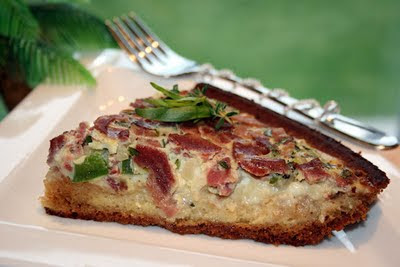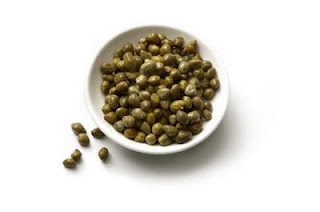I'm a teacher's aide for 4th and 5th grade at The Village Charter School in Boise, Idaho, and a 4.0 student working on my Bachelor's degree in Child Development at Ashford University.
Thursday, June 10, 2010
Capers
Capers are the unopened flower of a perennial Mediterranean shrub called the Capparis Spinosa. The caper bush or caper berry grows wild all over the Mediterranean on stony ground and can even be found growing from cracks in stone walls.
Although the caper is thought of as a gourmet ingredient, used in gourmet dishes, it's actually a weed. Many times it's pulled out as a weed because of its ability to grow wildly without human intervention. The caper buds are harvested between May and August and are best picked in the early morning before the bud has had time to open into a flower.
Fresh Capers, before pickling:
The caper is closely related to the cabbage family and resembles several spices, like cress, black and white mustard, wasabi and horseradish. Although the caper is chemically related to these spices, without treatment the caper directly from the bush is quite bland. To develop the peppery mustard flavor desirable in many dishes, from pasta and pizza to fish and salads, the capers must be preserved in either vinegar or salt. The isothiocyanates, a phytochemical occurring naturally in cruciferous vegetables, contained in capers will react to the salt or vinegar to bring out the intense flavor of the caper. The pickling brings out the spicy and slightly sour flavor of the caper and although similar in flavor intensity to the olive, they aren't eaten straight from the jar. They are best used to compliment a dish by adding saltiness toward or at the end of cooking. Because the pickled capers are salty, very little extra salt, if any, is needed in the dish. Small capers are called nonpareils and are considered to be more valuable. The larger capers are sometimes called a salad caper and have a milder taste than their smaller counterparts.
Capers have been around for thousands of years, mentioned in the story of Gilgamesh found on ancient Sumerian clay tablets dating back to 2700 B.C., as well as by the Roman, Apicus, who is believed to have written the very first cookbook in the 1st century. Caper bushes were used by the ancient Greeks not only for cooking, but also for medicinal purposes. The capers were an ingredient in their food while the leaves and roots were used to heal one's ailments.
Capers are high in anti-oxidants and assist with healthy liver function. Recent studies show that isothiocyanates neutralize carcinogens in the body and therefore are effective in lowering the risk of several types of cancers.
A few of the recipes we've enjoyed featuring capers can be found on Recipezaar.com:
Chickpea Salad with Cumin Vinaigrette by Kumquat the Cat's friend:
Simple Marinade and Rub for Fish by LifeIsGood
and
Pasta Puttanesca (the Madame's Pasta) by Pot Scrubber
Thursday, June 3, 2010
Tarragon and Thyme Quiche

Tarragon, known as the King of Herbs in France, is an herb used mostly in classic French cuisine for vinegar, salad dressings, Béarnaise sauce, and homemade mustard. When paired with parsley, chives and chervil, it becomes the seasoning blend known as fines herbes. The name originates from the Latin word dracunculus, meaning little dragon. After being translated in Arabic to tarkhum and in French to esdragon the herb’s name evolved into a combination of both words to form tarragon.
Tarragon is part of a family of herbs known as the Dragon Herbs, due to their snake-like root system, and because of their serpentine roots, the Dragon herbs were used as medicine in medieval times to cure stings, snake bites and the injuries sustained from rabid animals. French Tarragon possesses an essential volatile oil, chemically identical with that of Anise, and when used fresh, with a light hand, adds a sweet licorice essence to the dish. It compliments most vegetables, fish, poultry, soups, egg dishes, herbed butter or mayonnaise, and makes plain white vinegar dazzle for use in sauces and mustards. However, the anise-like oils are lost when the herb is dried and if the herb is cooked too long it becomes bitter.
Sometimes I try a recipe with a strange ingredient combination out of curiosity and sometimes it’s simply because everyone else is afraid to try it. (Remind me some time to tell you about Pineapple-Garlic Upside Down Cake!) When I stumbled onto the recipe for Tarragon-Thyme Quiche, posted to Food.com by Starman, I thought there must be a typo in the ingredients. I couldn’t imagine a savory pie filling inside a cookie crust, but the recipe had not yet been reviewed by another chef, so I knew I had to try it.
I admit I had my doubts right up until I was serving it, so even though my family is game to try anything once, I didn't tell them about the ingredients until I heard a lot of, "Mmmmm!" going on around the table. The dish strikes a balance between sweet and savory that is very satisfying, and with many ingredient variations available, this recipe is an excellent way to clean out the fridge at the end of the week. I used all fresh herbs, smoked Swiss cheese, turkey-bacon, white onion, green bell pepper, 2% milk and the graham cracker crust option. Every ingredient came together, melding into one beautiful harmony. So, get in touch with your adventurous side and give this quiche a try!
Tarragon and Thyme Quiche

Subscribe to:
Posts (Atom)






